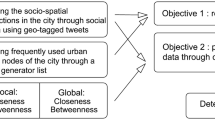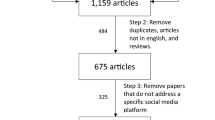Abstract
A variety of location based services, including navigation, geo-gaming, advertising, and vacation planning, rely on Point of Interest (POI) data. Mapping platforms and social media apps oftentimes host their own geo-datasets which leads to a plethora of data sources from which POIs can be extracted. Therefore it is crucial for an analyst to understand the nature of the data that are available on the different platforms, their purpose, their characteristics, and their data quality. This study extracts POIs for seven urban regions from seven mapping and social media platforms (Facebook, Foursquare, Google, Instagram, OSM, Twitter, and Yelp). It analyzes the POI data quality regarding coverage, point density, content classification, and positioning accuracy, and also examines the spatial relationship (e.g. segregation) between POIs from different platforms.
Access this chapter
Tax calculation will be finalised at checkout
Purchases are for personal use only
Similar content being viewed by others
Notes
References
Barron C, Neis P, Zipf A (2014) A comprehensive framework for intrinsic OpenStreetMap quality analysis. Trans GIS 18(6):877–895
Cvetojevic S, Juhász L, Hochmair HH (2016) Positional accuracy of twitter and instagram images in urban environments. GI_Forum 1:191–203
Dixon PM (2002) Ripley’s K function. In: El-Shaarawi AH, Piegorsch WW (eds) Encyclopedia of environmetrics. Wiley, Chichester
Duckham M, Winter S, Robinson M (2010) Including landmarks in routing instructions. J Location Based Serv 4(1):28–52
Fan H, Zipf A, Fu Q, Neis P (2014) Quality assessment for building footprints data on OpenStreetMap. Int J Geogr Inf Sci 28(14):700–719
Gröchenig S, Brunauer R, Rehrl K (2014) Estimating completeness of VGI datasets by analyzing community activity over time periods. In: Huerta J, Schade S, Granell C (eds) Connecting a digital Europe through location and place. Lecture notes in geoinformation and cartography. Springer, Berlin, pp 3–18
Hastings JT (2008) Automated conflation of digital gazetteer data. Int J Geogr Inf Sci 22(10):1109–1127
Heipke C (2010) Crowdsourcing geospatial data. ISPRS J Photogramm Remote Sens 65:550–557
Hochmair HH, Zielstra D (2013) Development and completeness of points of interest in free and proprietary data sets: a Florida case study. In: Jekel T, Car A, Strobl J, Griesebner G (eds), GI_Forum 2013. Creating the GISociety. Wichmann, Berlin, pp 39–48
Jackson SP, Mullen W, Agouris P, Crooks A, Croitoru A, Stefanidis A (2013) Assessing completeness and spatial error of features in volunteered geographic information. ISPRS Int J Geo-Inf 2:507–530
Juhász L, Hochmair HH (2016) Cross-linkage between Mapillary street level photos and OSM edits. In: Sarjakoski T, Santos MY, Sarjakoski T (eds) Geospatial data in a changing world: selected papers of the 19th AGILE conference on geographic information science. Lecture notes in geoinformation and cartography. Springer, Berlin, pp 141–156
Juhász L, Hochmair HH (2017) Where to catch ‘em all?’—a geographic analysis of Pokémon Go locations. Geo-spat Inf Sci 20(3):241–251
Juhász L, Rousell A, Arsanjani JJ (2016) Technical guidelines to extract and analyze VGI from different platforms. Data 1(3):15
Li L, Xing X, Xia H, Huang X (2016) Entropy-weighted instance matching between different sourcing points of interest. Entropy 18(2):45
Lim KH, Chan J, Leckie C, Karunasekera S (2015) Personalized tour recommendation based on user interests and points of interest visit durations. In: 24th international joint conference on artificial intelligence (IJCAI 2015), Buenos Aires, Brazil
McKenzie G, Janowicz K, Adams B (2014) A weighted multi-attribute method for matching user-generated points of interest. Cartogr Geogr Inf Sci 41(2):125–137
Mülligann C, Janowicz K, Ye M, Lee W-C (2011) Analyzing the spatial-semantic interaction of points of interest in volunteered geographic information. In: Egenhofer MJ, Giudice NA, Moratz R, Worboys MF (eds) Conference on spatial information theory (COSIT 2011). LNCS 6899. Springer, Berlin, pp 350–370
Nothegger C, Winter S, Raubal M (2004) Computation of the salience of features. Spat Cogn Comput 4:113–136
O’Sullivan D, Unwin DJ (2010) Geographic information analysis, 2nd edn. Wiley, Hoboken, New Jersey
Rösler R, Liebig T (2013) Using data from location based social networks for urban activity clustering. In: Vandenbroucke D, Bucher B, Crompvoets J (eds) Geographic information science at the heart of Europe. Lecture notes in geoinformation and cartography. Springer, Berlin
Senaratne H, Mobasheri A, Ali AL, Capineri C, Haklay M (2017) A review of volunteered geographic information quality assessment methods. Int J Geogr Inf Sci 31(1):138–167
Zhao B, Sui DZ (2017) True lies in geospatial big data: detecting location spoofing in social media. Ann GIS 23(1):1–14
Zielstra D, Hochmair HH (2013) Positional accuracy analysis of Flickr and Panoramio images for selected world regions. J Spat Sci 58(2):251–273
Zielstra D, Hochmair HH, Neis P (2013) Assessing the effect of data imports on the completeness of OpenStreetMap—A United States case study. Trans GIS 17(3):315–334
Author information
Authors and Affiliations
Corresponding author
Editor information
Editors and Affiliations
Rights and permissions
Copyright information
© 2018 Springer International Publishing AG
About this paper
Cite this paper
Hochmair, H.H., Juhász, L., Cvetojevic, S. (2018). Data Quality of Points of Interest in Selected Mapping and Social Media Platforms. In: Kiefer, P., Huang, H., Van de Weghe, N., Raubal, M. (eds) Progress in Location Based Services 2018. LBS 2018. Lecture Notes in Geoinformation and Cartography. Springer, Cham. https://doi.org/10.1007/978-3-319-71470-7_15
Download citation
DOI: https://doi.org/10.1007/978-3-319-71470-7_15
Published:
Publisher Name: Springer, Cham
Print ISBN: 978-3-319-71469-1
Online ISBN: 978-3-319-71470-7
eBook Packages: Earth and Environmental ScienceEarth and Environmental Science (R0)




